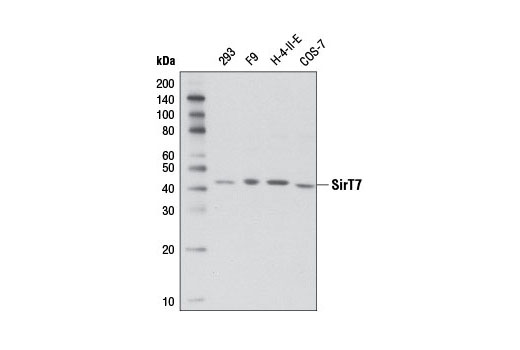WB, IP
H M R Mk
Endogenous
45
Rabbit IgG
#Q9NRC8
51547
Product Information
Product Usage Information
| Application | Dilution |
|---|---|
| Western Blotting | 1:1000 |
| Immunoprecipitation | 1:200 |
Storage
Specificity / Sensitivity
Species Reactivity:
Human, Mouse, Rat, Monkey
Source / Purification
Monoclonal antibody is produced by immunizing animals with a recombinant protein specific to the amino terminus of human SirT7 protein.
Background
The Silent Information Regulator (SIR2) family of genes is a highly conserved group of genes that encode nicotinamide adenine dinucleotide (NAD)-dependent protein deacetylases, also known as Class III histone deacetylases. The first discovered and best characterized of these genes is Saccharomyces cerevisiae Sir2, which is involved in silencing of mating type loci, telomere maintenance, DNA damage response, and cell aging (1). SirT7, a mammalian homolog of Sir2, is localized primarily in the nucleolus and is most prominently expressed in hematopoietic cells, especially myeloid progenitor cells (2). SirT7 is recruited to chromatin by sequence-specific DNA binding transcription factors such as Elk-4, where it functions to deacetylate Lys18 of histone H3 at gene promoters and facilitate transcriptional repression (3). Interestingly, overexpression of SirT7 induces a global decrease in histone H3 Lys18 acetylation levels, a phenotype that has been associated with poor prognosis in prostate, lung, kidney, and pancreatic cancers in the research literature (3-5). Furthermore, studies have also shown that SirT7 is required for the maintenance of several transformed phenotypes of cancer cells, including anchorage-independent cell growth, growth in low serum conditions, and tumor formation in xenograft assays (3). SirT7 is also required for the E1A-induced decrease in histone H3 Lys18 acetylation, induction of cell-cycle entry, and escape from contact inhibition (3). Taken together, these findings strongly suggest that SirT7 is an important regulator of cellular transformation. Research has shown that the SirT7 gene is located on chromosome 17q25.3, a region that is frequently altered in acute leukemia and lymphoma (2), and SirT7 overexpression and amplification have been detected in multiple types of cancer (6-8).
- Guarente, L. (1999) Nat Genet 23, 281-5.
- Voelter-Mahlknecht, S. et al. (2006) Int J Oncol 28, 899-908.
- Barber, M.F. et al. (2012) Nature 487, 114-8.
- Manuyakorn, A. et al. (2010) J Clin Oncol 28, 1358-65.
- Seligson, D.B. et al. (2009) Am J Pathol 174, 1619-28.
- Ashraf, N. et al. (2006) Br J Cancer 95, 1056-61.
- de Nigris, F. et al. (2002) Br J Cancer 86, 917-23.
- Frye, R. (2002) Br J Cancer 87, 1479.
Species Reactivity
Species reactivity is determined by testing in at least one approved application (e.g., western blot).
Western Blot Buffer
IMPORTANT: For western blots, incubate membrane with diluted primary antibody in 5% w/v BSA, 1X TBS, 0.1% Tween® 20 at 4°C with gentle shaking, overnight.
Applications Key
WB: Western Blotting IP: Immunoprecipitation
Cross-Reactivity Key
H: human M: mouse R: rat Hm: hamster Mk: monkey Vir: virus Mi: mink C: chicken Dm: D. melanogaster X: Xenopus Z: zebrafish B: bovine Dg: dog Pg: pig Sc: S. cerevisiae Ce: C. elegans Hr: horse GP: Guinea Pig Rab: rabbit All: all species expected
Trademarks and Patents
使用に関する制限
法的な権限を与えられたCSTの担当者が署名した書面によって別途明示的に合意された場合を除き、 CST、その関連会社または代理店が提供する製品には以下の条件が適用されます。お客様が定める条件でここに定められた条件に含まれるものを超えるもの、 または、ここに定められた条件と異なるものは、法的な権限を与えられたCSTの担当者が別途書面にて受諾した場合を除き、拒絶され、 いかなる効力も効果も有しません。
研究専用 (For Research Use Only) またはこれに類似する表示がされた製品は、 いかなる目的についても FDA または外国もしくは国内のその他の規制機関により承認、認可または許可を受けていません。 お客様は製品を診断もしくは治療目的で使用してはならず、また、製品に表示された内容に違反する方法で使用してはなりません。 CST が販売または使用許諾する製品は、エンドユーザーであるお客様に対し、使途を研究および開発のみに限定して提供されるものです。 診断、予防もしくは治療目的で製品を使用することまたは製品を再販売 (単独であるか他の製品等の一部であるかを問いません) もしくはその他の商業的利用の目的で購入することについては、CST から別途許諾を得る必要があります。 お客様は以下の事項を遵守しなければなりません。(a) CST の製品 (単独であるか他の資材と一緒であるかを問いません) を販売、使用許諾、貸与、寄付もしくはその他の態様で第三者に譲渡したり使用させたりしてはなりません。また、商用の製品を製造するために CST の製品を使用してはなりません。(b) 複製、改変、リバースエンジニアリング、逆コンパイル、 分解または他の方法により製品の構造または技術を解明しようとしてはなりません。また、 CST の製品またはサービスと競合する製品またはサービスを開発する目的で CST の製品を使用してはなりません。(c) CST の製品の商標、商号、ロゴ、特許または著作権に関する通知または表示を除去したり改変したりしてはなりません。(d) CST の製品をCST 製品販売条件(CST’s Product Terms of Sale) および該当する書面のみに従って使用しなければなりません。(e) CST の製品に関連してお客様が使用する第三者の製品またはサービスに関する使用許諾条件、 サービス提供条件またはこれに類する合意事項を遵守しなければなりません。

